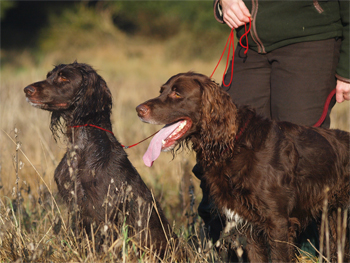Unlike its wirehaired and shorthaired cousins, the longhair pointer is a newcomer to the UK. The first to be introduced to England was a puppy called Freya of Melissant who was born here in quarantine in 1994
Is it a setter or is it some kind of spaniel? This is a question that owners of German longhaired pointers (GLPs) are used to, for in this country the longhair is the least known of the German gundog breeds. It is also the most setter-like of the German HPRs, not only in its looks but also in the way it hunts. In its native country, where the longhair is relatively scarce, the wirehair is the most popular of pointers. The longhair is regarded primarily as a specialist bird dog used in open country, whereas the wirehair is more of an all-rounder employed for everything from pheasants and hare to deer and boar.
Unlike its wirehaired and shorthaired cousins, the longhair pointer is a newcomer to the UK. The first to be introduced to England was a puppy called Freya of Melissant who was born here in quarantine in 1994; her eight siblings all went to Ireland. At the time, importing a pregnant bitch was a way around our stringent quarantine laws, with the bitch giving birth in quarantine before returning to her country, leaving the puppies behind.
In April 1996, David Winser, a leading handler and breeder of GSPs, imported another bitch in whelp who had eight puppies. She was Iris VD Kreppelse Heide, an FTCh in Holland and the litter sister to the twice world champion Igor VD Kreppelse Heide. David and his wife Eileen were much taken with Iris and managed to persuade her Dutch owners to let her stay with them in Cambridgeshire.
As a result, Freya and Iris became the foundation stock for the GLP in Britain; the Kennel Club registered the breed in 1999. Today it is firmly established, with 16 litters producing 129 puppies in the past five years, but it still remains one of the rarest of the Continental dog breeds in the UK.
The Dutch ancestry of the original dogs is noteworthy as there are two quite distinct types of GLP: the Dutch dogs are rather more athletic and streamlined than those with German bloodlines. However, such differences may be the sorts of things that enthusiasts love to debate but they are of little real consequence to most of us. The truth is that the GLP is an exceptionally eye-catching dog. While bred primarily for work rather than show, there is no difference between working and show lines.
The setter-like appearance is no accident. Early in their history, in the mid-19th century, both pointer and setter blood from England was introduced to improve the dogs’ speed and hunting ability and to make the animals less obstinate and more biddable. The breed standard was established in 1879 at the same time as the shorthaired pointer, with the wirehair following three years later.
Germans take the breeding of their hunting dogs very seriously, which is why the modern GLP doesn’t look very different from its 19th-century ancestors. It is a sporty animal, similar to an Irish setter. Unlike the latter, which can only be red, the GLP comes in any shade of brown, from solid brown to white ticked with brown roan. Reflecting its German ancestry, its colour is always referred to as brown, never chocolate or liver.

The very first pheasant I ever shot off a point was over a striking brown and white GLP belonging to David Winser. That was 10 years ago. Since then, I’ve watched GLPs working for falcons in the wilds of Sutherland and competing in field trials. Most recently, I’ve shot over them during a rough-shooting day in the Suffolk Brecks, thanks to an invitation from Rob and Theo Gould. These two have both trained GLPs to become field trial champions, a unique achievement.
I’ve owned and worked English springers for much of my life and still reckon that the springer is the ultimate rough-shooter’s dog. However, spending a day with a trio of top-class German longhairs was a pertinent reminder of the breed’s ability and the pleasure of pursuing wild game with well-trained dogs.
The theory was to shoot game off points but this is not easy with genuinely wild game at the tail-end of the season. Though we had three dogs out, only one was worked at a time with two people shooting. It became a matter of watching the hunting dog, reading its behaviour and anticipating what might happen. GLPs are fast and stylish hunters, taking in large areas of ground effortlessly. They hunt by air-scenting, working with a high head carriage in contrast to a spaniel with its nose to the ground.
Points were relatively few but they were sufficient to set the pulses racing. The final bag was over 20 head, made up of hare, rabbit, red-legged partridges, cock pheasants and a single woodcock. Many more woodcock were seen but one was thought sufficient to give all the dogs a chance to retrieve it; this was a training day, albeit a pleasurably sporting one.
It is often a criticism of HPR breeds that they should really be called HPrs; they all love to hunt, most point naturally but many are poor retrievers. Not so the GLP. All the game was retrieved with speed, confidence and commendable tenderness. I came home with four partridges, each of which had been retrieved more than once, but plucking revealed not a single tooth mark. If you want a talented pot-hunting dog, it would be difficult to beat this longhaired German.
More gun dogs in The Field




